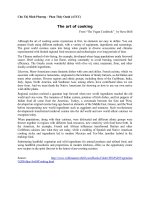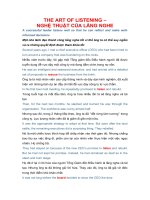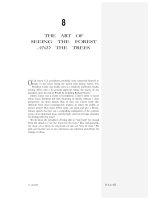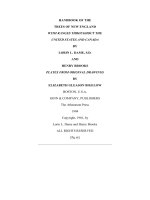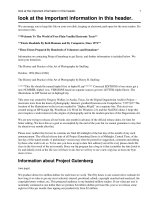THE ART OF SEEING THE FOREST AND THE TREES
Bạn đang xem bản rút gọn của tài liệu. Xem và tải ngay bản đầy đủ của tài liệu tại đây (216.86 KB, 9 trang )
17. září 2004
114 ze 412
8
THE ART OF
SEEING THE FOREST
AND
THE TREES
f all recent U.S. presidents, probably none immersed himself so
deeply in the issues facing the nation than Jimmy Carter. Yet,
President Carter was widely seen as a relatively ineffective leader,
leaving office with a 22 percent approval rating, the lowest of any
president since the end of World II, including Richard Nixon.'
Jimmy Carter was a victim of complexity. Carter's thirst to know
about issues firsthand left him drowning in details, without a clear
perspective on those details. But, in fact, was Carter really that
different from most contemporary leaders, in either the public or
private sector? How many CEOs today can stand and give a fifteen-
minute speech that lays out a compelling explanation of the systemic
causes of an important issue, and the high- and low-leverage strategies
for dealing with that issue?
We all know the metaphor of being able to "step back" far enough
from the details to "see the forest for the trees." But, unfortunately,
for most of us when we step back we just see "lots of trees." We
pick our favorite one or two and focus our attention and efforts for
change on those.
O
17. září 2004
115 ze 412
Systems
thinking finds it greatest benefits in
helping us
distinguish
high-
from low-leverage changes in highly complex situations. In
effect, the
art of systems thinking lies in seeing
through
complexity
to
the
underlying structures generating change. Systems thinking
does
not mean ignoring complexity. Rather, it means organizing complexity
into a coherent story that illuminates the causes of problems and how
they can be remedied in enduring ways. The increasing complexity of
today's world leads many managers to assume that they lack
information they need to act effectively. I would suggest that the
fundamental "information problem" faced by managers is not too
little information but too much information. What we most need are
ways to know what is important and what is not important, what
variables to focus on and which to pay less attention to—and we need
ways to do this which can help groups or teams develop shared
understanding.
THE PERILS OF
BEING A
PIONEER
One of the most spectacular and regrettable rises and falls of a pro-
totype learning organization was People Express Airlines.
2
It is a
parable of complexity that could not be disentangled in time to save the
organization. Founded in 1980 to provide low-cost, high-quality airline
service to travelers in the Eastern United States, People Express grew
in five years to be the nation's fifth-largest carrier. Along the way,
People Express established a reputation as a corporate pioneer,
crafting a stirring corporate philosophy articulated by charismatic
founder Don Burr. "Most organizations believe that humans are
generally bad and you have to control them and watch them," said
Burr in one typical statement. "At People Express, people are trusted
to do a good job until they prove they definitely won't . . ."
3
The airline
translated that philosophy into a host of innovative human resource
policies that have since been adopted by many other firms, such as job
rotation, team management, universal stock ownership, and only four
levels of hierarchy (with only four pay levels in the whole company).
Yet, despite its spectacular early success, in September 1986 People
Express was taken over by Texas Air Corporation, having lost $133
million in the first six months of 1986 alone. Many theories have been
offered to explain People's growth and
17. září 2004
116 ze 412
collapse. Burr and the airline had gained much public attention for
unusually "soft," people-oriented management policies. Hard-
headed business analysts felt that People's decline proved that
"business is business." Lofty ideals and democratic workplaces
conflict with profits, they said. Others blamed Burr and his manage-
ment team for failing to provide ongoing strategic leadership—espe-
cially after the purchase of Denver-based Frontier Airlines in 1985,
which brought in four thousand new employees who shared neither
People's values nor its business strategy.
Some of People's own executives, including Burr himself, offer a
different explanation. In 1984, partly in response to the success of low-
cost carriers such as People Express, American Airlines introduced its
Sabre seat-reservation computer system, ushering in a new era of "load
management"—meaning that airlines could offer a limited number of
seats at much-reduced prices, while still booking business passengers
and others at full coach. It was a dramatic change in the airline
business, and it brought People Express up against significant price
competition for the first time.
It is no wonder that People Express poses such a puzzle. Under-
standing what went wrong requires sorting out an enormously com-
plex set of factors such as:
FLEET
Planes
Capacity of aircraft
Routes
Scheduled flights
Competitor routes
& flights Service
hours per
plane (per day)
Fuel efficiency
HUMAN
RESOURCES
Service personnel
Aircraft personnel
Maintenance
personnel Hiring
Training Turnover
Morale
Productivity
Experience Team
management Job
rotation Stock
ownership
Temporaries
COMPETITIVE
FACTORS
Market size Market
segments Reputation
Service quality
Competitor service
quality
Fares
"Load
management"
Competitor fares
17. září 2004
117 ze 412
FINANCIAL
VARIABLES
Revenues
Profit
Cost of plane
operations Cost
of service
operations Cost
of marketing
Wages Stock price
Growth rate Debt
Interest Rate
"POLICY
LEVERS"
(A few of the key decisions that
People's management must make)
Buying planes
Hiring people
Pricing
Marketing expenditures "Service
scope" (range of services to offer)
Such "laundry lists" of important variables hint at the enormous
detail complexity of realistic management problems. It's easy to get lost
in the "trees" of these details and lose sight of the "forest"—
mastering the dynamic complexity essential to successful strategy.
Here's where the discipline of systems thinking finds its greatest
advantage. By using the systems archetypes we can learn how to
"structure" the details into a coherent picture of the forces at play.
A THEORY OF WHAT
HAPPENED AT PEOPLE EXPRESS
Disentangling a complex story such as People Express Airlines starts
with identifying the forces that shaped its evolution and the structures
that may have lain behind those forces. This can lead to a very
different picture of a firm's problems than suggested by just looking at
the events.
People Express started with an innovative product concept, and
the lowest costs in the industry. (People Express was the first airline
founded after the 1978 U.S. airline deregulation.) The airline boasted a
combination of deeply discounted fares and friendly, no-frills services
(for example, meals and baggage handling were extra charges). Flying
People Express on many of its East Coast routes was cheaper
17. září 2004
118 ze 412
than taking a bus. This quickly attracted so many new customers
that, by the third quarter of 1982, Burr announced at People Ex-
press's quarterly financial meeting: "We're now the biggest carrier, in
terms of departures, at any New York airport."
4
In its early days, with universal stock ownership, People's em-
ployees had tremendous morale buoyed by the company's rapid success
and exciting vision. "I have never flown on an aircraft," wrote one
journalist in 1982, "whose help is so cheerful and invested in their
work."
5
As Burr said, "At People Express, attitude is as important as
altitude."
But that early reputation, and those low prices, brought demand
that began, by mid-1982, to outstrip the company's ability to serve.
Lori Dubose, managing officer for Human Resources, was quoted as
having trouble finding "enough people to staff adequately" and still
"have some time for management development." By November
1982, one third of People's staff was temporary help—four hundred
temporaries in all. In terms of simple head count, there were probably
enough "Customer Service Managers," as People Express's service
personnel were called, to keep pace. But the innovative job rotation
and team management concepts meant that training and assimilation
of service personnel took much longer than in more traditional airlines.
Despite these difficulties, demand for People's deep discount
flights continued to grow phenomenally. Passenger seat miles more
than doubled in 1982, and again in 1983. By the end of 1983, People
was one of the most profitable carriers in the industry. Its stock was
trading at $22 a share, up from $8.50 at startup. Despite being over-
worked, many of People's employees were growing wealthy. Burr
preached the merits of hard work in the pursuit of a lofty vision:
"People get more fatigued and stressed when they don't have a lot to
do. I really believe that, and I think I have tested it. . . . It's
sensational what direction can do. The beauty of the human condition
is the magic people are capable of when there's direction. When there's
no direction, you're not capable of much." Revenues doubled again
in 1984, although profits did not rise proportionately.
Meanwhile, People Express's customers were complaining more
about service problems. There were more and more ticketing and
reservation delays, and canceled or overbooked flights. On-board
flight attendants became less friendly and less efficient. Customers
forgave all this at first, and kept returning to the airline. Thus, there
was no apparent penalty for poor service. But during 1984 and 1985,
